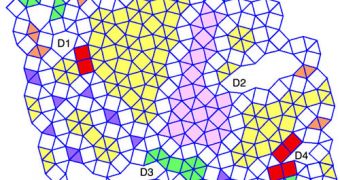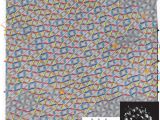Quasicrystals are weird structures, aperiodic structures (aperiodic = lack of translational symmetry, which means that a shifted copy will never match exactly its original) that differ from crystals by lacking the regular repeating structure of crystal structures.
The first officially reported case of what came to be known as quasicrystals was made by Dan Shechtman and coworkers in 1984, and since then they have appeared in metals and a few other materials.
A group of scientists reported in the 11 May Physical Review Letters the creation of polymer quasicrystals. Their approach took into account the fact that the spacing between the polymers structures is 100 times larger than between atoms, so it's difficult to apply the quantum mechanical theories from previous quasicrystals to this new type.
Tomonari Dotera of Kyoto University and Yushu Matsushita of Nagoya University in Japan and their colleagues have introduced long chain polymer molecules to the exquisite club of the quasicrystals. They mixed three polymer types that divided into many single-polymer regions upon casting in micron-thick sheets.
The regions formed two-dimensional patterns in the film, organized by the star polymers (Y-shaped elements that feature all three types joined at a single point), at the intersection of the three regions.
Afterwards, it was just a matter of connecting the dots between regions of the same polymer type to form some very complex geometrical shapes, like triangles and squares in a ratio of 2 to 1. While looking for deviations in the pattern, the team observed a type of quasicrystal with a triangle-to-square ratio of 2,309.
The perfect quasycristal has a ratio of 2,305, so the team knew they had created a quaiscrystal polymer.
Future applications may include new types of photonic crystals that manipulate light, with possible uses in optical chips that would use "light circuits" instead of electrons.

 14 DAY TRIAL //
14 DAY TRIAL // 
